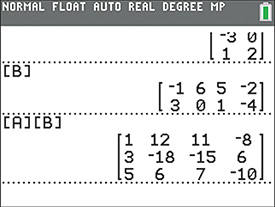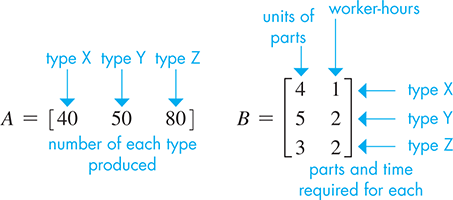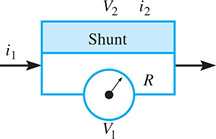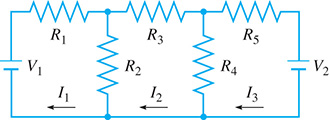16.2 Multiplication of Matrices
Multiplication of Matrices • Identity Matrix • Inverse of a Matrix
The definition for the multiplication of matrices does not have an intuitive basis. However, through the solution of a system of linear equations we can, at least in part, show why multiplication is defined as it is. Consider Example 1.
EXAMPLE 1 Reasoning for definition of multiplication
If we solve the system of equations
we get Checking this solution in each of the equations, we get
Let us represent the coefficients of the equations by the matrix and the solutions by the matrix If we now indicate the multiplications of these matrices and perform it as shown
we note that we obtain a matrix that properly represents the right-side values of the equations. (Note the products and sums in the resulting matrix.)
Following reasons along the lines indicated in Example 1, we now define the multiplication of matrices. If the number of columns in a first matrix equals the number of rows in a second matrix, the product of these matrices is formed as follows: The element in a specified row and a specified column of the product matrix is the sum of the products formed by multiplying each element in the specified row of the first matrix by the corresponding element in the specific column of the second matrix. The product matrix will have the same number of rows as the first matrix and the same number of columns as the second matrix. Consider the following examples.
EXAMPLE 2 Multiplying matrices
Find the product AB, where
With two columns in matrix A and two rows in matrix B, the product can be formed. The element in the first row and first column of the product is the sum of the products of the corresponding elements of the first row of A and first column of B. The elements in the first row and second column of the product is the sum of the products of corresponding elements of the first row of A and second column of B. We continue until we have three rows (the number in A) and four columns (the number in B).

The elements used to form the element in the first row and first column and the element in the third row and second column of the product are outlined in color. Figure 16.4 shows the calculator display for the matrix product AB.

Fig. 16.4
Graphing calculator keystrokes: bit.ly/
In trying to form the product BA, we see that B has four columns and A has three rows. Because these numbers are not the same, the product cannot be formed.
CAUTION
Therefore, which means matrix multiplication is not commutative (except in special cases), and therefore differs from multiplication of real numbers.
EXAMPLE 3
The product of two matrices below may be formed because the first matrix has four columns and the second matrix has four rows. The matrix is formed as shown.
IDENTITY MATRIX
There are two special matrices of particular importance in the multiplication of matrices. The first of these is the identity matrix I, which is a square matrix with 1’s for elements of the principal diagonal with all other elements zero. (The principal diagonal starts with the element ) It has the property that if it is multiplied by another square matrix with the same number of rows and columns, then the second matrix equals the product matrix.
EXAMPLE 4 Identity matrix
Show that for the matrix
Because A has two rows and two columns, we choose I with two rows and two columns. Therefore, for this case
Forming the indicated products, we have results as follows:
Therefore, we see that
INVERSE OF A MATRIX
For a given square matrix A, its inverse is the other important special matrix. The matrix A and its inverse have the property that
If the product of two square matrices equals the identity matrix, the matrices are called inverses of each other. In the next section, we develop the procedure for finding the inverse of a square matrix, and the section that follows shows how the inverse is used in the solution of systems of equations. At this point, we simply show that the product of certain matrices equals the identity matrix and that therefore these matrices are inverses of each other.
CAUTION
Only square matrices can have inverses, and if the determinant of a matrix is zero, then the inverse does not exist.
EXAMPLE 5 Inverse matrix
For the given matrices A and B, show that and therefore that
Forming the products AB and BA, we have the following:
Since and and
EXAMPLE 6 Matrix multiplication—transmission production
A company makes three types of automobile transmissions: 4-gear manual (type X), 4-gear automatic (type Y), and 5-gear automatic (type Z). In one day, it produces 40 of type X, 50 of type Y, and 80 of type Z. Required for production are 4 units of parts (some preassembled) and 1 worker-hour for type X, 5 units of parts and 2 worker-hours for type Y, and 3 units of parts and 2 worker-hours for type Z. Letting matrix A represent the number of each type produced, and matrix B represent the parts and time requirements, we have

The product AB gives the total number of units of parts and the total number of worker-hours needed for the day’s production in a one-row, two-column matrix:

Therefore, 650 units of parts and 300 worker-hours are required.
We have seen that matrix multiplication is not commutative (see Example 2); that is, in general. This differs from the multiplication of real numbers. Another difference is that it is possible that even though neither A nor B is O. There are also some similarities. For example, where I and the number 1 are analogous. Also, the distributive property holds for matrix multiplication.
EXERCISES 16.2
In Exercises 1 and 2, make the given changes in the indicated examples of this section and then perform the indicated multiplications.
In Example 2, interchange columns 1 and 2 in matrix A and then do the multiplication.
In Example 5, in A change to 2 and to 3, in B change 2 to and 3 to and then do the multiplications.
In Exercises 3–10, perform the indicated multiplications.
In Exercises 11–14, use a graphing calculator to perform the indicated multiplications.
In Exercises 15–18, find, if possible, AB and BA. If it is not possible, explain why.
In Exercises 19–22, show that
In Exercises 23–26, determine whether or not
In Exercises 27–30, determine by matrix multiplication whether or not A is the proper matrix of solution values.
In Exercises 31–34, perform the indicated matrix multiplications on a calculator, using the following matrices. For matrix A,
Show that
Show that
Show that
Show that
In Exercises 35–48, solve the given problems.
For matrices and show that
For matrix show that
Using two rows and columns, show that
 For where show that and Explain the similarity with and
For where show that and Explain the similarity with and Show that for
By using show that does not necessarily mean that
From past records, satellite television Company A finds that among its current customers, 92% will still be a customer one year from now and the remaining 8% will be lost to other competing companies. Also, among customers who are currently with other companies, 14% will switch to Company A within one year and the remaining 86% will remain with other companies. This is represented by the following transition matrix T:
Company A currently has 40% of the market share, given by Find the market share of Company A after one year by multiplying
In Exercise 41, the market share of Company A in future years can be found by multiplying by the transition matrix T repeatedly. What would the market share of Company A be after 3 years?
In studying the motion of electrons, one of the Pauli spin matrices used is where Show that
To rotate a set of points counterclockwise about the origin by angle we multiply If a photo on a computer screen has corners at and find the coordinates of the corners after the photo has been rotated counterclockwise about the origin by .
In an ammeter, nearly all the electric current flows through a shunt, and the remaining known fraction of current is measured by the meter. See Fig. 16.5. From the given matrix equation, find voltage and current in terms of and resistance R, whichever may be applicable.

Fig. 16.5
In the theory related to the reproduction of color photography, the equation
is found. The X, Y, and Z represent the red, green, and blue densities of the reproductions, respectively, and the x, y, and z represent the red, green, and blue densities, respectively, of the subject. Give the equations relating X, Y, and Z and x, y, and z.
The path of an Earth satellite can be written as
where distances are in miles. What type of curve is represented? (See Section 14.1.)
Using Kirchhoff’s laws on the circuit shown in Fig. 16.6, the following matrix equation is found. By matrix multiplication, find the resulting system of equations.

Fig. 16.6
Answers to Practice Exercises
4 rows, 4 columns
